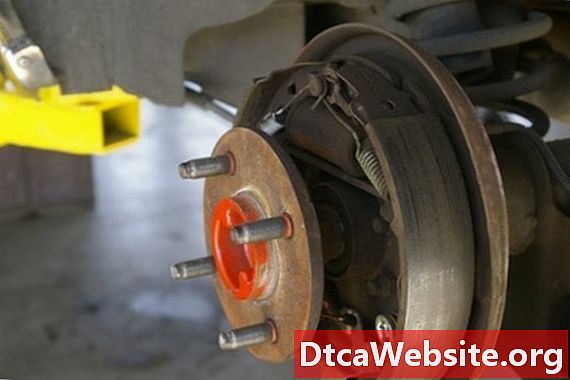
Contenu

Two- and four-wheel drive automatic and manual transmissions are almost identical in just about every way. They feature the same housing, gear ratios and often – but not always – have the same spline count on the output shaft. Primary differences are the two-wheel transmission output shaft is longer than the four-wheel version and four-wheel transmissions mate to a transfer case. Some automakers build their two-wheel transmissions so they can be converted to four-wheel models.
Background
Many car two-wheel transmissions can be converted to truck four-wheel drive, but they are not necessarily ideal for the demands of four-wheeling. General Motors’ automobile transmissions, including the performance Muncie M21 and M22, and Saginaw and Borg Warner T-10, can convert to four-wheel as long as they are not asked to do any heavy knockabout off-roading. The lack of low gears makes transversing rough terrain difficult. Two-wheel truck transmissions, such as the Muncie SM420, SM465 and the NV4500 and NV3500, easily mate with a four-wheel drive transfer case and can handle the demands of rough off-roading.
Identification
A two-wheel transmission is identified by its long tailshaft with the rear section consisting of an overdrive unit. The four-wheel drive transmission also has a rear overdrive unit section, but it mates with a transfer case that distributes the power to the front and rear axles. Two-wheel transmissions have no transfer case. However, some vehicles like the two-wheel drive Ford Bronco II, have a dummy transfer case to ease conversion to four-wheel drive by only requiring a new output shaft.
Major Differences
The GM SM465 and TH350, and Aisin AX-15 transmissions typify some of the differences between two- and four-wheelers. GM produced the SM465 manual transmission from 1968 to 1991 for its half- through 3-ton Chevrolet and GMC trucks and sport utility vehicles. Through 1978, the SM465 two- and four-wheel transmissions featured identical internal parts except for the output shaft. The four-wheel version had a 10-spline output shaft and transfer case. The two-wheel model had a 35-spline output shaft with the conventional two-wheel-style tailhousing. From 1979 to 1991, the four-wheel SM465 featured a shorter 32-spline output shaft. The two-wheel SM465’s 35-spline remained and its internals mirrored the four-wheel version. The TH350 automatic came in both two- and four-wheel applications with the two-wheel versions possessing tailhousings lengths of 6, 9 and 12 inches while the four-wheeler output mated with the transfer case. The AX-15 two- and four-wheel transmissions featured the same internal parts, but the two-wheel version had a 14-spline shaft and the four-wheel has a 23-spline shaft.
Transfer Case
The transfer case connected to the rear of the transmission should be a dead giveaway that the vehicle is four-wheel drive. However, the transfer case may be a dummy available for later conversion for four-wheeling. Operating transfer cases connect to the transmission and use two drive shafts to split the power between the front and rear axles. These are a part-time manual transfer case operated by the driver or part-time electronic activated with a switch. Some vehicles, such as sports cars, have full-time permanently locked transfer cases.


